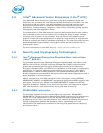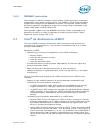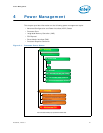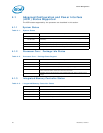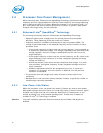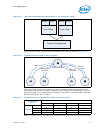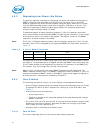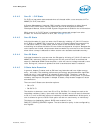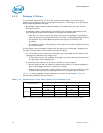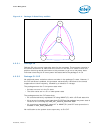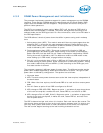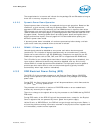
Power Management
52 Datasheet, Volume 1
4.2.3 Requesting Low-Power Idle States
The primary software interfaces for requesting low power idle states are through the
MWAIT instruction with sub-state hints and the HLT instruction (for C1 and C1E).
However, software may make C-state requests using the legacy method of I/O reads
from the ACPI-defined processor clock control registers, referred to as P_LVLx. This
method of requesting C-states provides legacy support for operating systems that
initiate C-state transitions using I/O reads.
To seamless support of legacy operating systems, P_LVLx I/O reads are converted
within the processor to the equivalent MWAIT C-state request. Therefore, P_LVLx reads
do not directly result in I/O reads to the system. The feature, known as I/O MWAIT
redirection, must be enabled in the BIOS.
Note: The P_LVLx I/O Monitor address needs to be set up before using the P_LVLx I/O read
interface. Each P-LVLx is mapped to the supported MWAIT(Cx) instruction as shown in
Table 4-9.
The BIOS can write to the C-state range field of the PMG_IO_CAPTURE MSR to restrict
the range of I/O addresses that are trapped and emulate MWAIT like functionality. Any
P_LVLx reads outside of this range does not cause an I/O redirection to an MWAIT(Cx)-
like request. They fall through like a normal I/O instruction.
Note: When P_LVLx I/O instructions are used, MWAIT substates cannot be defined. The
MWAIT substate is always zero if I/O MWAIT redirection is used. By default, P_LVLx I/O
redirections enable the MWAIT 'break on EFLAGS.IF’ feature that triggers a wakeup on
an interrupt even if interrupts are masked by EFLAGS.IF.
4.2.4 Core C-states
The following are general rules for all core C-states, unless specified otherwise:
• A core C-State is determined by the lowest numerical thread state (such as Thread
0 requests C1E while Thread 1 requests C3, resulting in a core C1E state). See
Table 4-7.
• A core transitions to C0 state when:
— An interrupt occurs
— There is an access to the monitored address if the state was entered using an
MWAIT instruction
• For core C1/C1E, core C3, and core C6, an interrupt directed toward a single thread
wakes only that thread. However, since both threads are no longer at the same
core C-state, the core resolves to C0.
• A system reset re-initializes all processor cores
4.2.4.1 Core C0 State
The normal operating state of a core where code is being executed.
Table 4-9. P_LVLx to MWAIT Conversion
P_LVLx MWAIT(Cx) Notes
P_LVL2 MWAIT(C3)
P_LVL3 MWAIT(C6) C6. No sub-states allowed.



